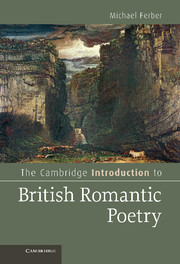Book contents
- Frontmatter
- Contents
- Preface
- Acknowledgments
- Chapter 1 Introduction
- Chapter 2 The poet
- Chapter 3 “Tintern Abbey”
- Chapter 4 Romantic odes
- Chapter 5 The French Revolution
- Chapter 6 Romantic sonnets
- Chapter 7 Romantic love lyrics
- Chapter 8 Romantic ballads
- Chapter 9 Romantic epics and romances
- Chapter 10 Romantic verse drama
- Chapter 11 Romantic satire
- Appendix
- Notes
- Further reading
- Index
Chapter 6 - Romantic sonnets
Published online by Cambridge University Press: 05 June 2012
- Frontmatter
- Contents
- Preface
- Acknowledgments
- Chapter 1 Introduction
- Chapter 2 The poet
- Chapter 3 “Tintern Abbey”
- Chapter 4 Romantic odes
- Chapter 5 The French Revolution
- Chapter 6 Romantic sonnets
- Chapter 7 Romantic love lyrics
- Chapter 8 Romantic ballads
- Chapter 9 Romantic epics and romances
- Chapter 10 Romantic verse drama
- Chapter 11 Romantic satire
- Appendix
- Notes
- Further reading
- Index
Summary
When we think of the English sonnet we inevitably think first of Shakespeare, Spenser, Sidney, Donne, and other poets of the Renaissance, but the second great age of the sonnet was the Romantic era. “English Romanticism,” Harold Bloom memorably put it, “was a renaissance of the Renaissance,” and one of the distinctive features of this second renaissance was a revival of lyric forms, among which the sonnet had pride of place. A convenient way to review its history before Romanticism is to look at one of Wordsworth’s, a sonnet on the sonnet, published in 1827:
Scorn not the Sonnet; Critic, you have frowned,
Mindless of its just honours; with this key
Shakespeare unlocked his heart; the melody
Of this small lute gave ease to Petrarch’s wound;
A thousand times this pipe did Tasso sound; 5
With it Camoëns soothed an exile’s grief;
The Sonnet glittered a gay myrtle leaf
Amid the cypress with which Dante crowned
His visionary brow; a glow-worm lamp,
It cheered mild Spenser, called from Faery-land 10
To struggle through dark ways; and when a damp
Fell round the path of Milton, in his hand
The Thing became a trumpet; whence he blew
Soul-animating strains—alas, too few!
This is a fairly comprehensive history of the sonnet, naming seven of its greatest creators, three Italian, three English, and one Portuguese (Camoëns), and in all but one case offering a distinctive image for what the sonnet became in their hands. Three of the images are musical instruments, culminating in Milton’s trumpet, the traditional instrument of the epic. It omits Ronsard, Lope de Vega, and other French and Spanish Renaissance sonneteers, but Wordsworth would have had to write at least two sonnets to get everybody in. This one, appropriately enough, is a cross between the Italian or Petrarchan form, which is divided into an octave of two identically rhymed quatrains (abba abba) followed by a sestet (cdecde or some variation), and the Shakespearean form, which falls into three quatrains followed by a couplet (abab cdcd efef gg). The syntax, moreover, sometimes straddles the quatrain structure: “with which Dante crowned / His visionary brow” runs right across the most important break point in the Petrarchan pattern, where there was usually a volta or “turn,” while Milton occupies not just the final couplet but a line and a half before it. It is not the greatest of Wordsworth’s sonnets, but it is something of a tour de force, with some tidbit to chew on about each poet.
- Type
- Chapter
- Information
- The Cambridge Introduction to British Romantic Poetry , pp. 115 - 129Publisher: Cambridge University PressPrint publication year: 2012



